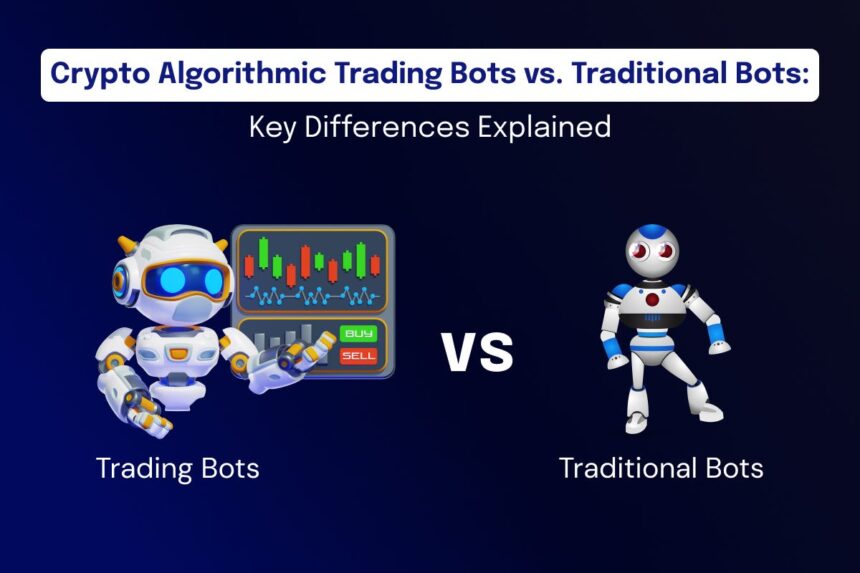The financial industry has experienced rapid changes in recent years, largely fueled by digital assets, blockchain technology, and advanced automation. Among the most talked-about developments is the rise of crypto algorithmic trading bots. These software-driven programs are designed to analyze market data, identify trading opportunities, and execute trades automatically. While trading bots are not new — traditional financial markets have relied on them for decades — their application in cryptocurrencies introduces unique features and challenges.
Businesses exploring opportunities in this space often interact with blockchain development services to create custom trading applications that meet the distinct requirements of digital asset markets. Understanding how crypto bots differ from traditional ones is essential for companies, investors, and even blockchain developers who want to offer practical solutions.
This comprehensive blog explores the core differences between crypto algorithmic trading bots and their traditional counterparts. We will cover their structures, functions, benefits, limitations, and most importantly, what businesses should consider before integrating or developing them.
What Are Trading Bots?
A trading bot is essentially a piece of software that executes trades based on pre-defined rules. These rules can be as simple as buying when prices drop below a certain point or as complex as using advanced statistical models and AI-driven predictions.
Traditional Trading Bots
Traditional bots are primarily used in stock markets, forex, and commodities trading. They are built to work with centralized exchanges, where rules are strictly defined and market hours are limited.
Crypto Algorithmic Bots
In contrast, crypto trading bots operate in 24/7 markets without central oversight. This makes them more dynamic but also more complex. They need to accommodate irregular volatility, sudden liquidity changes, and risks specific to digital assets, such as exchange outages or wallet security.
Algorithmic trading, sometimes called algo-trading, became mainstream in traditional markets in the early 2000s. By relying on automation, algorithmic systems could process vast amounts of data in milliseconds — something no human trader could achieve consistently.
In cryptocurrencies, algorithmic trading became popular much faster. This is because crypto exchanges operate globally at all times, creating continuous opportunities for arbitrage, momentum strategies, and pattern recognition. Trading bots, therefore, became indispensable tools for both institutional and retail traders.
Whether traditional or crypto-based, bots typically consist of three layers:
- Market Data Analysis — Collecting and interpreting real-time price, volume, and order book data.
- Signal Generation — Using predefined strategies to determine when to buy or sell.
- Execution — Placing orders quickly and efficiently with an exchange.
While the structure is similar, the underlying data sources, execution methods, and regulatory frameworks vary dramatically between traditional and crypto environments.
Here’s where the distinctions become clear:
1. Market Hours
- Traditional markets operate on fixed schedules (e.g., 9:30 AM — 4:00 PM EST for the stock market).
- Crypto markets never sleep, which means crypto bots must be capable of non-stop monitoring and quick decision-making.
2. Market Volatility
- Stocks and forex markets experience fluctuations but are more stable compared to crypto.
- Crypto markets are infamous for extreme volatility, demanding bots that can handle sudden and sharp movements.
3. Liquidity Structures
- In traditional markets, liquidity is deep and highly synchronized across exchanges.
- Crypto liquidity is fragmented, with hundreds of exchanges offering different prices for the same assets.
4. Regulation
- Traditional markets are heavily regulated, requiring strict compliance.
- Cryptocurrency regulations vary drastically across jurisdictions, often leaving grey areas for developers.
5. Execution Speed and Infrastructure
- Traditional bots rely on co-location and high-frequency infrastructures in well-established data centers.
- Crypto bots often interact with APIs provided by exchanges, making them more dependent on third-party performance quality.
Traditional Bot Strategies
- Mean Reversion
- Statistical Arbitrage
- Basket Trading
- Latency Arbitrage
Crypto Bot Strategies
- Arbitrage across multiple exchanges
- Trend-following strategies in highly volatile markets
- Market-making in tokens with growing interest
- Exploiting liquidity mining or decentralized finance (DeFi) yield opportunities
Each environment has unique strategies that adapt to volatility, liquidity, and regulatory conditions.
Creating trading bots is not as simple as writing a script. Businesses must consider:
- Data feed reliability
- Exchange API integration
- Latency management
- Cloud or dedicated hosting solutions
- Wallet integrations and transaction costs
- Security against attacks, hacks, or price manipulation
This makes the role of professional blockchain development companies critical when designing crypto bots, compared to firms working in conventional equities or forex development spaces.
Traditional trading bots operate in secure systems where brokers and exchanges already provide high-level security safeguards.
In contrast, crypto trading bots must address risks such as:
- Hacking of exchange APIs
- Vulnerabilities in wallet integrations
- Risks from decentralized platforms where code may contain bugs
- Phishing and malicious bot impersonation
Managing these risks requires sophisticated coding standards and resilient safeguards during the development phase.
For financial firms, the decision to build or use bots often comes down to:
- Market opportunity: Crypto offers higher volatility, and therefore higher potential gains.
- Cost efficiency: Traditional market entry requires brokers, clearing firms, and licenses; crypto only needs access to exchanges.
- Innovation scope: Blockchain-based bots enable integration with DeFi protocols, NFTs, and token staking — something traditional bots don’t cover.
- Hedge Funds use bots for risk management and systematic trading.
- Retail Traders rely on bots to stay active in the market without manual supervision.
- Businesses and Exchanges implement automated bots for liquidity provision.
- Blockchain Startups integrate custom bots with services like arbitrage engines or decentralized trading solutions.
Despite the growth of crypto bots, challenges remain:
- Exchange reliability issues
- Regulatory uncertainty
- Rapidly evolving attack vectors in blockchain
- Technological barriers for non-technical businesses
Organizations need expert guidance to navigate these challenges effectively.
Crypto algorithmic trading bots and traditional bots share a fundamental principle: automating decisions for faster and more efficient trading. Yet, the differences between them highlight why businesses must approach crypto bot development with fresh perspectives. Continuous markets, volatility, fragmented liquidity, and regulatory uncertainty make crypto bots distinct from traditional ones — not just in operations but in the very way they’re conceived and maintained.
For businesses looking to create or integrate algorithmic bots in the crypto ecosystem, expertise in blockchain is critical. Partnering with skilled developers allows companies to build reliable, secure, and efficient trading systems that align with market realities.
At Codezeros, we help businesses build the future of trading with advanced blockchain development solutions. Whether you are a financial institution, a startup, or an enterprise exploring digital asset automation, our blockchain development services can help you conceptualize, design, and launch reliable trading bots that perform in today’s evolving markets.
Get in touch with Codezeros today to discuss your next blockchain development project.










